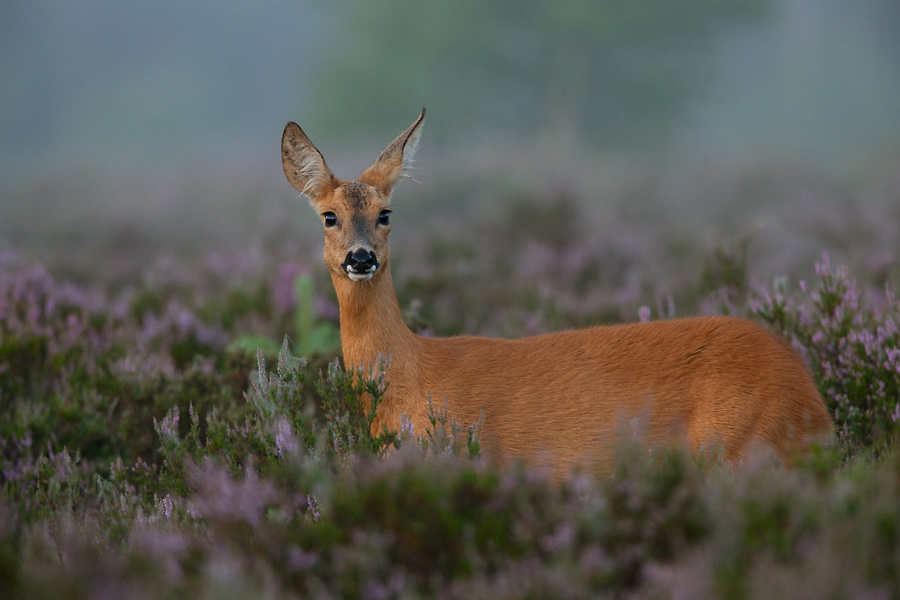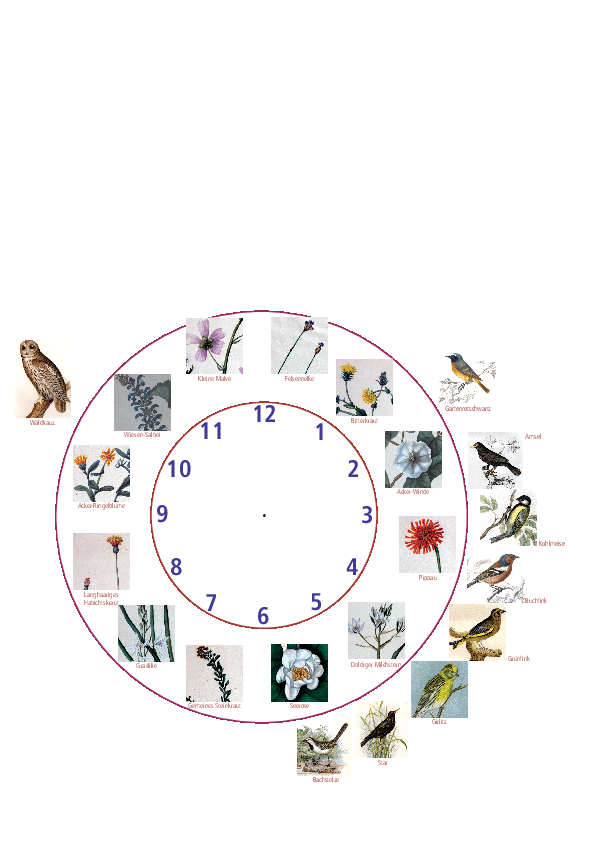Who invented the clock?
Not the Swiss – but nature!
by Heini Hofmann
Switzerland is not only synonymous with chocolate, cheese and machinery; it is above all the land of clocks and watches, the cradle of mechanical timekeeping. The Maîtrise des horlogers de Genève, founded in 1601, was probably the first watchmakers’ guild in the world. Nonetheless, it was not the Swiss who invented the watch, rather, it was nature!
Admittedly, before the electronic and mechanical clocks there were also chronometers such as the sundial with the wandering shadow, the water and hourglass, and the oil and candle clocks. But before man began to measure time, nature had long known the biological clock, the so-called inner clock, a sophisticated masterpiece against which every chronometer fades.
Flower and bird clock
The more cultivated and civilised mankind became, the more it felt the desire to divide and measure time, this precious but perishable good. The banal question “What time is it?” became the standard phrase. But what to do when there is no clock around? Very simple: listen to the birds and watch the flowers! Thus the famous Swedish natural scientist Carl von Linné, founder of biological systema-tics, presented a flower clock as early as 1751, which was based on the temporally staggered opening and closing of different flowering plants and seemed to be quite precise.
In even more detail, a 19th century bird clock attempted to construct a scale of time measurement; a sample of this: 1.30am-2am chaffinch, 2am-2.30am blackcap, 2.30am-3am quail, 3am3.30am whiskered warbler, 3.30am-4am blackbird, 4am-4.30am oriole, 4.30am-5am willow tit, 5am-5.30am house sparrow. Well, every early bird and nature lover knows from his own experience that this organic chronometer should not be taken too seriously; because birds chirp at fixed times, however, overlapping in time.
Inner, biological clock
In the realm of civilisation today, practically everyone wears a watch on their arm, and there are chronometers everywhere, in electronic devices, in cars, on church steeples, in public buildings and in the private living room. However, are we aware that clocks tick in our bodies too, in millions upon millions? The whole of life is chronometered, and all living beings, whether human or protozoa, are guided in their daily rhythm by internal, biological clocks.
These molecular pacemakers control – in accordance with the rotation of the earth – a large part of the biological functions in a period of about 24 hours, which corresponds to about one day. This is why the term circadian rhythm, composed of the Latin words circa (approximately) and dies (day), was coined; it is controlled by light perception via receptors that have not yet been conclusively researched. The science that deals with this is called chronobiology.
This inner clock functions like an oscillating circuit that regulates the daily rhythm. It helps us fall asleep or wake up, for example, but can also irritate us when travelling to other time zones due to the unpleasant jet lag. Or it confuses us in underground facilities without daylight, which is why 24-hour dials were used in military fortresses and command bunkers. Ignoring the biorhythm can even lead to chronic illnesses of shift workers or to loss of concentration, as evidenced by the accumulation of industrial incidents in the early hours of the morning.
Innate sense of time
How an internal clock works is demonstrated by research using the example of migratory birds which do not depend on the weather but on the seasonal course of the length of the day. When the days become shorter in autumn, they begin to prepare for the long-distance flight by building up fat reserves (as food for the journey) after having already renewed their feathers during the summer moult – comparable to the great service provided for the car before the holiday journey. As a fuel reserve, they eat up a good fat pad, often up to twice their own weight.
Even the metabolism is changed during the migration period in such a way that the birds can obtain up to 95 per cent of the necessary operating energy from body fat during long-distance flights. Not only the physiology, but also the behaviour is reversed by the internal clock. Before the migration, many otherwise purely diurnal birds suddenly become nocturnal. Even captive migratory birds show this nocturnal restlessness with hopping and fluttering, whereby these activities are geared to the innate direction of migration and are also more pronounced in long-distance flyers than in short-distance migrants. This points to an inherited sense of direction and distance.
No station clocks
When biological clocks were discovered in flies and humans at the end of the 1950s, it was still assumed that such a timer could only be located in the brain. However, once such circadian rhythms could also be detected in bacteria, fungi and plants that do not have central control mechanisms, it became clear that body cells also have their own biological clocks.
While the control of biorhythms was previously only attributed to the brain, more recent research has been able to show that organ tissues and individual cells also have clocks that are not just simple oscillators, but autonomous bio-timers that function independently of a central switch point, i.e. they are not attached to a master clock like station clocks. And yet there seems to be a connection in that the decentralised clocks of vertebrates work together with the pineal gland in the brain, which controls the daily rhythm by secreting the sleep hormone melatonin.
Ingenius clock gene
Intensive research was carried out to find the responsible light receiver of organic animal clocks. Once it was established that the two types of retinal receptors, i.e. rods and cones, were not required for the calibration of the organic clock, the interest in photoreceptor function focused on the group of light-active substances that are common in both animals and plants and which are called cryptochromes in accordance with their as yet undeciphered function. It is assumed that such circadian light sensors send impulses to the brain which then releases messenger substances into the bloodstream, thereby synchronising the billions of body clocks with the rotation of the earth.
Since zebrafish is one of the best-studied models of vertebrate genetics, the activity of the so-called clock gene, which is largely responsible for the functioning of the circadian clock in the animal kingdom, was studied. The activity of this clock gene is determined by measuring the concentration of messenger RNA, i.e. the blueprint of the gene that controls protein factories. And, lo and behold, the clock activity fluctuated during the course of the day not only in the brain, but also in other organs. This in turn, suggests that the decentralised clocks are not merely external dials of a central clock.
The clock of fate
In addition to the circadian clock, which controls the periodic processes of life, there is also the slower but all the more relentlessly “ticking” life clock, which determines when the first whiskers sprout or when the female breast begins to develop, when body growth stops, when the skin ages and the hair greys. This chronometer of destiny which individually measures life span and the functioning of which is still a mystery, is like a leaking hourglass that no mortal can turn over and which one day – stands still. •
(Translation Current Concerns)
Nobel Prize in Medicine 2017 for Chronobiology
HH. The topicality of research into the biological clock is demonstrated by the fact that the chronobiology research branch was awarded the 2017 Nobel Prize in Medicine: Scientists Jeffrey C. Hall, Michael Rosbash and Michael W. Young, all three USA, received it „for their discoveries of molecular mechanisms controlling the circadian rhythm”.
They provided evidence of what earlier researchers had already suspected based on experiments on mutant fruit flies, namely that the internal clock was genetically anchored. They managed to isolate the gene suspected of being responsible (called the period) and to characterise other genes and proteins involved.
And they were able to show how these molecular building blocks control the biological clockwork And they were able to show how these molecular building blocks control the biological clockwork and are also responsible for the hormone secretions that – thanks to a rhythmic feedback mechanism – get us going when we wake up in the morning (cortisol) or sleepy when we go to bed (melatonin) while doing so also regulate body temperature and blood pressure.
Love Chronometer

HH. An important set of rules is the “Liebesuhr” (love watch); it gives animals an idea of when breeding time is. But not everyone feels “spring“ at the same time, as the example of indigenous shellfish shows, which move the hot days into the cool season. The rutting season for the stag is in october, for the chamois it lasts until november, and the wild boar only roars in december. The deer, on the other hand, mate in the middle of midsummer, but then leave the fertilised egg cells to rest for almost half a year before implantation in the uterus and thus embryonic growth begins.
But how does this “love watch” actually “tick” – for example in the deer? The longer days in early summer stimulate the pituitary gland and thereby start the production of sex hormones. The goats determine the actual rutting date by sending pheromones (scent hormones) to which the goats react in the preliminary rush. But they are only really ready to mate within a few hours.
Similar to the migration of birds, the weather is irrelevant during the rut. Indirectly, however; because deer goats can extend the gestation time a little in unfavorable weather, which is why the setting date in the same population can fluctuate somewhat from year to year. Such a time difference is then also transferred to the next ovulation and the beginning of another rutting season. The time of mating is therefore not dependent on the weather, but on the last date of setting.
